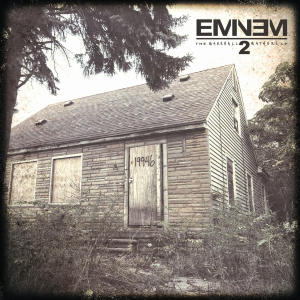Marshall Bruce Mathers III launched his new album, “The Marshall Mathers LP II,” and lost himself in the music.
On Oct. 17, 1972 in Kansas City. MO., Mathers was born. He was a product of Marshall Bruce Mathers II and Deborah R. Nelson-Mathers, who was only 15 when she gave birth.
His stage name, Eminem, stemmed from his full name, Marshall Mathers, “M and M.”
He also used the name Slim Shady as an excuse to make his politically incorrect and offensive music and try to keep Eminem away from Marshall Mathers, father of four.
Mathers was a kid from the streets. He grew up in the slums of Detroit and attended Lincoln High School until 1989. Working hard on his cassettes, Mathers and his girlfriend, Kimberly, whom he would later marry and divorce, had a baby girl, Halie Jade Scott, on Christmas Day in 1995.
He worked at a family restaurant until his debut album, “Infinite,” was released in ‘96. Later that year, Dr. Dre signed Eminem to his label, Aftermath.
After free styling on the L.A stage, Eminem released his second album, “The Slim Shady LP,” in ’99.
The album hit No. 2 on the Billboard charts within weeks and reached platinum three times.
This is where the legacy of Marshall Mathers began. He released his first Marshall Mathers LP with songs such as “Stan” ft. Dido, “The Real Slim Shady,” and “Kim.” All of these songs would prove that Eminem was here to stay, as the whole album was a huge hit and won he a Grammy Award for Best Rap Album.
As Eminem got bigger, so did his problems.
He showed this in his music and it was very easy to tell he was disturbed. After a while, Eminem realized he needed to clean up his act, even if it would mean selling fewer records.
In 2010, Eminem released his album “Recovery,” and instead of hurting his record sales, it helped them.
The new Marshall Mathers was a hit in the world of rap, and he was very content in his choice to clean up.
Fast forwarding to now, Eminem released his first single, “Survival,” from his unnamed album as a theme song to the video game “Call of Duty: Ghosts.” This song wasn’t a huge hit in the rap world.
However, his next single, “Berzerk,” a remix of an old Beastie Boys song, had listeners loving Eminem.
The uptempo song made fun of TV star Khloe Kardashian and professional basketball player Lamar Odom.
People wondered if, maybe, he had returned to the Slim Shady that he had left behind.
The album was set to hit the world on Nov. 5, but it was leaked six days early. Eminem was not that upset by this, and he allowed the 16-song album to be played on iTunes Radio.
There was still more to come. The deluxe edition didn’t make its splash until the original release date, and it included collaborations with Kendrick Lamar, Skylar Grey, Nate Ruess, Rhianna, Jamie N Commons, Sia, and X Ambassadors, as well as the album’s two singles “Rap God” and “The Monster” ft. Rihanna.
Nobody knew what to expect from Eminem, whether he was reverting back to his old ways or moving on.
When the album came out, it was clear that he was moving on.
He wrote a song, “Headlights,” ft. Nate Ruess, as an apology to his mother and an explanation for the songs and nasty references he wrote about her in his younger years.
The album, to me, is a wonderful representation of who Eminem is, and of the life he has led.
He has definitely grown up and is trying to stay on a better path. He wants a new life, no matter what the cost, and for all of us to know that he is not afraid.

